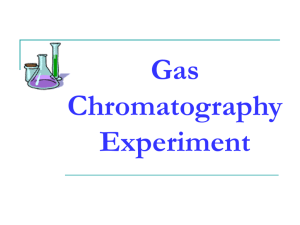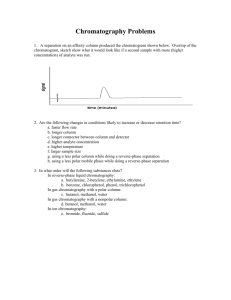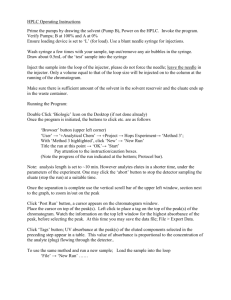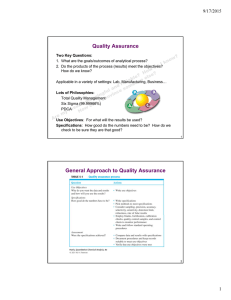Determination of Alcohols by Gas Chromatography INTRODUCTION
advertisement
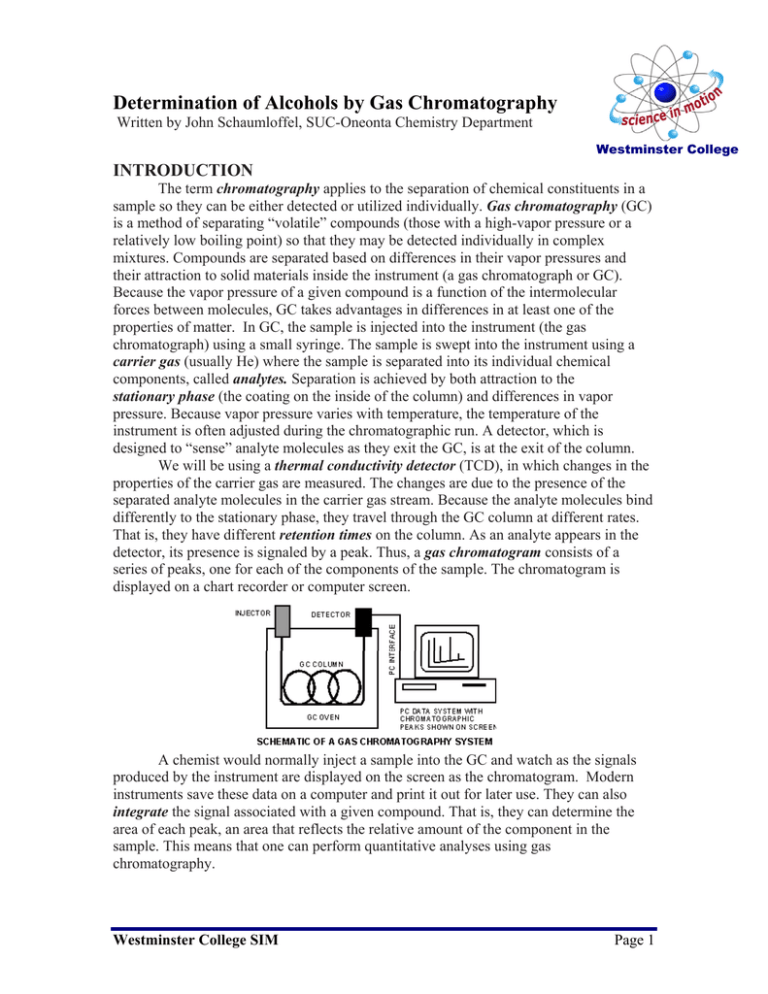
Determination of Alcohols by Gas Chromatography Written by John Schaumloffel, SUC-Oneonta Chemistry Department Westminster College INTRODUCTION The term chromatography applies to the separation of chemical constituents in a sample so they can be either detected or utilized individually. Gas chromatography (GC) is a method of separating “volatile” compounds (those with a high-vapor pressure or a relatively low boiling point) so that they may be detected individually in complex mixtures. Compounds are separated based on differences in their vapor pressures and their attraction to solid materials inside the instrument (a gas chromatograph or GC). Because the vapor pressure of a given compound is a function of the intermolecular forces between molecules, GC takes advantages in differences in at least one of the properties of matter. In GC, the sample is injected into the instrument (the gas chromatograph) using a small syringe. The sample is swept into the instrument using a carrier gas (usually He) where the sample is separated into its individual chemical components, called analytes. Separation is achieved by both attraction to the stationary phase (the coating on the inside of the column) and differences in vapor pressure. Because vapor pressure varies with temperature, the temperature of the instrument is often adjusted during the chromatographic run. A detector, which is designed to “sense” analyte molecules as they exit the GC, is at the exit of the column. We will be using a thermal conductivity detector (TCD), in which changes in the properties of the carrier gas are measured. The changes are due to the presence of the separated analyte molecules in the carrier gas stream. Because the analyte molecules bind differently to the stationary phase, they travel through the GC column at different rates. That is, they have different retention times on the column. As an analyte appears in the detector, its presence is signaled by a peak. Thus, a gas chromatogram consists of a series of peaks, one for each of the components of the sample. The chromatogram is displayed on a chart recorder or computer screen. A chemist would normally inject a sample into the GC and watch as the signals produced by the instrument are displayed on the screen as the chromatogram. Modern instruments save these data on a computer and print it out for later use. They can also integrate the signal associated with a given compound. That is, they can determine the area of each peak, an area that reflects the relative amount of the component in the sample. This means that one can perform quantitative analyses using gas chromatography. Westminster College SIM Page 1 Determination of Alcohol by Gas Chromatography An alternative to computer analysis is to record the chromatogram on a chart recorder. The areas can be determined by calculating the area of the peaks based on the assumption that they are triangular in shape. By comparing the areas of the chromatographic peaks the instrument records for both the sample and a standard containing a known concentration of the analyte, one can determine the concentration of the analyte in the sample. Chromatographic peaks can be quantified easily if certain variables are kept constant (e.g. extraction efficiency, amount injected into the GC). Quantitative calculations are often made according to the following relationship, which eliminates the need for a calibration curve if the analyte response is directly proportional to analyte concentration over a wide range. [Analyte]sample Peak area sample [Analytes]standard Peak area of standard or [Analyte}sample [Analyte]standard Peak area of standard Peak area of sample An example chromatogram is also shown below. (tR)A −Retention Time for A (tR)B −Retention Time for B tM −Dead Time (non retented (tR)B ΔZ (tR)A compound) hA −Height for A hA hB hB −Height for B bA −Base for A bB −Base for B Δ Z − Difference in Retention time between A and B bA bB The width of the peak at the base is shown above as bA and bB, and the height of the peak is the height above the baseline (the horizontal dashed line above). The formula for the area of a triangle is A = ½ bh. In today's experiment, you will be presented with a scenario in which you have been approached by the owner of a chemical products company who is concerned about the quality of his starting materials. He wants to supply a shampoo manufacturer with hexanol and octanol (two materials used to make hair gels), but needs to be sure that his products are free from impurities so he isn’t fined by US-SMOB (United States Shampoo Manufacturers Oversight Board). You need to determine which, if any contaminant(s) are Westminster College SIM Page 2 Determination of Alcohol by Gas Chromatography in his samples of starting material and how much is there. Any contaminant (any nonhexanol or non-octanol compounds) must be there at concentrations less than 250,000 ppm (parts per million) by volume. MATERIALS 5 – 1 mL pipets 4 – 50 mL beakers with watch glass covers Pentanol Hexanol Octanol Heptanol Unknown sample Gas Chromatography System Kimwipes 1 - 5μ liter syringe SAFETY 1. Always wear safety glasses in the lab and observe safe and prudent laboratory practices. 2. Handle the syringes carefully. The syringes are very dangerous, especially when filled with hazardous chemicals. They also break easily. Do not allow the syringe to roll off of the lab bench. When injecting the sample, push the plunger straight so that it does not bend. 3. The gas chromatograph is similar to an oven, so the port may be hot. Use caution. 4. Most alcohols are irritating and flammable. Wipe up any spills with paper towels immediately. PROCEDURES Part 1: Preparation of the Standard 1. Using a transfer pipet prepare a mixture of 1 mL each of pentanol, hexanol, heptanol, and octanol. 2. Mix well and cover with a watch glass. 3. This is your Standard, containing approximately equal concentrations of each analyte (250,000 μg/mL of each analyte). (Each component is 25% by volume of the sample.) Part 2: Analysis (all three lab partners): Your instructor will assist you with the operation of the GC. 1. Your instructor will provide you with an Unknown Sample, which is mixtures of the four possible alcohols. You will also receive chromatograms of three Pure Solutions, (pentanol, hexanol, and octanol). 2. Place the tip of the 5μ liter syringe into the Standard Alcohol mixture. Pump the syringe 3 or 4 times to remove the air; draw up 1 μL of the mixture into the syringe. Make sure there in no air in the syringe and then wipe the needle with a clean kimwipe. 3. Inject 1 μL of Standard into the injector port on the upper left of the GC. Caution: Do not touch the injector port. The injector port is hot. Westminster College SIM Page 3 Determination of Alcohol by Gas Chromatography 4. Collect the chromatogram printout. The chart paper moves at a rate of 1 cm/minute. At the end of each run, label the chromatogram with the sample name, injection volume, and group name. You should now know what the retention time is for each of the four alcohols. By comparing the three Pure Solution chromatograms with the chromatogram of the Standard, you can identify the peaks. The peak for heptanol will be the one in your Standard that does not correspond to any of the three Pure Solution peaks! 5. Analyze the Unknown Samples by injecting 1 μL of each into the GC. Your Unknown Sample may contain one, two, or three of the compounds! CALCULATIONS Two data tables appear below for your convenience. 1. For the chromatogram of your Standard, measure the distance from the time of injection to the center of each peak in cm. Knowing that the chart moves .5 inches/minute, calculate the retention time for each peak (analyte). Use your Pure Solution chromatograms to assign identities to each peak. Record this in Table 1. 2. On the Standard, Sample 1, Sample 2 and Sample 3 chromatograms, calculate the area of each peak by first assuming it is a triangle. Then, draw a triangle, with all three sides within the peak. Remember that the area of a triangle is (1/2)(base)(height). Calculate the area (in cm2) for each peak. Record this information in Table 1 and Table 2. (Note: compare your calculations to those provided by the GC printout.) 3. Using the Standard Solution, calculate a "response factor" by dividing the concentration of the Standard by the peak area. Your final answer will be in ppm/cm2. Record this in Table 1. 4. Calculate the concentration of the analytes you observed in Unknown Samples 1-3 by multiplying the peak area for those samples times the response factor. Be sure to use the unique peak areas and response factors for each analyte (refer to Table 1 for this information). If an analyte is not present in the sample, you would not see a peak, and would not calculate a concentration for it. It would be “not detected”. 5. Finally, calculate the percent composition of each sample. Table 1: Initial Concentrations and Chromatographic Results (mg/mL = ppm) Standard Retention Time Concentration (minutes) (ppm) 1 250,000 2 250,000 3 250,000 Westminster College SIM Area (cm2) Response Factor (ppm/cm2) Page 4 Determination of Alcohol by Gas Chromatography Table 2: Compositions and Concentrations Concentration (ppm) = area (cm2) X Response factor (ppm/cm2) Unknown 1 Area (cm2) Concentration (ppm) Percent Composition Area (cm2) Concentration (ppm) Percent Composition Area (cm2) Concentration (ppm) Percent Composition Component 1 Component 2 Component 3 Actual composition Unknown 2 Component 1 Component 2 Component 3 Actual composition Unknown 3 Component 1 Component 2 Component 3 Actual composition Westminster College SIM Page 5
